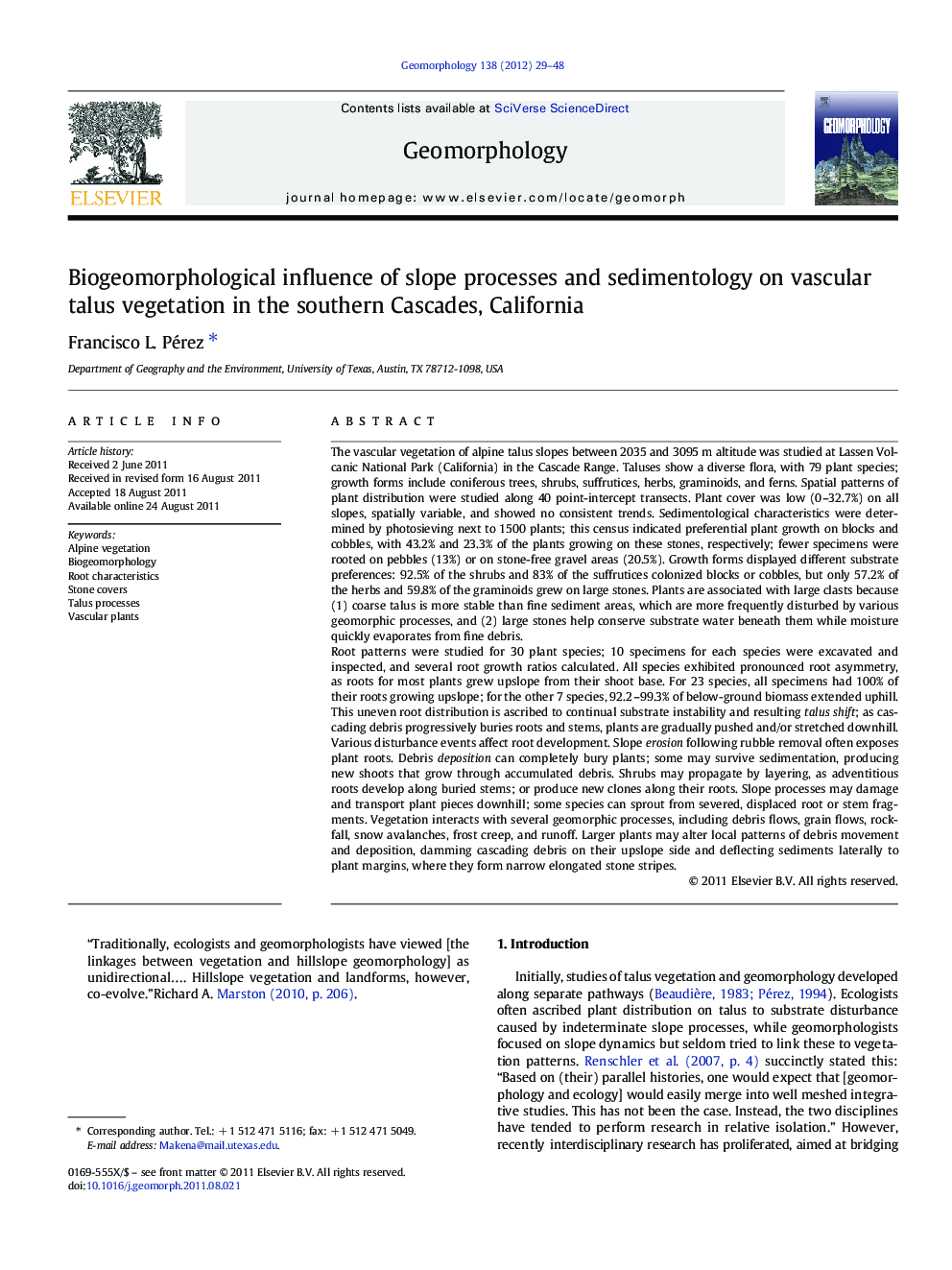| کد مقاله | کد نشریه | سال انتشار | مقاله انگلیسی | نسخه تمام متن |
|---|---|---|---|---|
| 4685345 | 1349485 | 2012 | 20 صفحه PDF | دانلود رایگان |

The vascular vegetation of alpine talus slopes between 2035 and 3095 m altitude was studied at Lassen Volcanic National Park (California) in the Cascade Range. Taluses show a diverse flora, with 79 plant species; growth forms include coniferous trees, shrubs, suffrutices, herbs, graminoids, and ferns. Spatial patterns of plant distribution were studied along 40 point-intercept transects. Plant cover was low (0–32.7%) on all slopes, spatially variable, and showed no consistent trends. Sedimentological characteristics were determined by photosieving next to 1500 plants; this census indicated preferential plant growth on blocks and cobbles, with 43.2% and 23.3% of the plants growing on these stones, respectively; fewer specimens were rooted on pebbles (13%) or on stone-free gravel areas (20.5%). Growth forms displayed different substrate preferences: 92.5% of the shrubs and 83% of the suffrutices colonized blocks or cobbles, but only 57.2% of the herbs and 59.8% of the graminoids grew on large stones. Plants are associated with large clasts because (1) coarse talus is more stable than fine sediment areas, which are more frequently disturbed by various geomorphic processes, and (2) large stones help conserve substrate water beneath them while moisture quickly evaporates from fine debris.Root patterns were studied for 30 plant species; 10 specimens for each species were excavated and inspected, and several root growth ratios calculated. All species exhibited pronounced root asymmetry, as roots for most plants grew upslope from their shoot base. For 23 species, all specimens had 100% of their roots growing upslope; for the other 7 species, 92.2–99.3% of below-ground biomass extended uphill. This uneven root distribution is ascribed to continual substrate instability and resulting talus shift; as cascading debris progressively buries roots and stems, plants are gradually pushed and/or stretched downhill. Various disturbance events affect root development. Slope erosion following rubble removal often exposes plant roots. Debris deposition can completely bury plants; some may survive sedimentation, producing new shoots that grow through accumulated debris. Shrubs may propagate by layering, as adventitious roots develop along buried stems; or produce new clones along their roots. Slope processes may damage and transport plant pieces downhill; some species can sprout from severed, displaced root or stem fragments. Vegetation interacts with several geomorphic processes, including debris flows, grain flows, rockfall, snow avalanches, frost creep, and runoff. Larger plants may alter local patterns of debris movement and deposition, damming cascading debris on their upslope side and deflecting sediments laterally to plant margins, where they form narrow elongated stone stripes.
► Talus flora has 79 species of trees, shrubs, suffrutices, herbs, graminoids and ferns.
► Plant cover was low (0–32.7%) on all slopes, and showed no consistent spatial trends.
► Most plants (66.5%) grow near large rocks; only 33.5% develop on pebbles or gravel.
► 30 plant species show sharp root asymmetry; most roots grow upslope from plant's base.
► Moving talus debris buries plants, pushing and stretching roots and stems downhill.
Journal: Geomorphology - Volume 138, Issue 1, February 2012, Pages 29–48